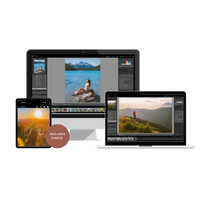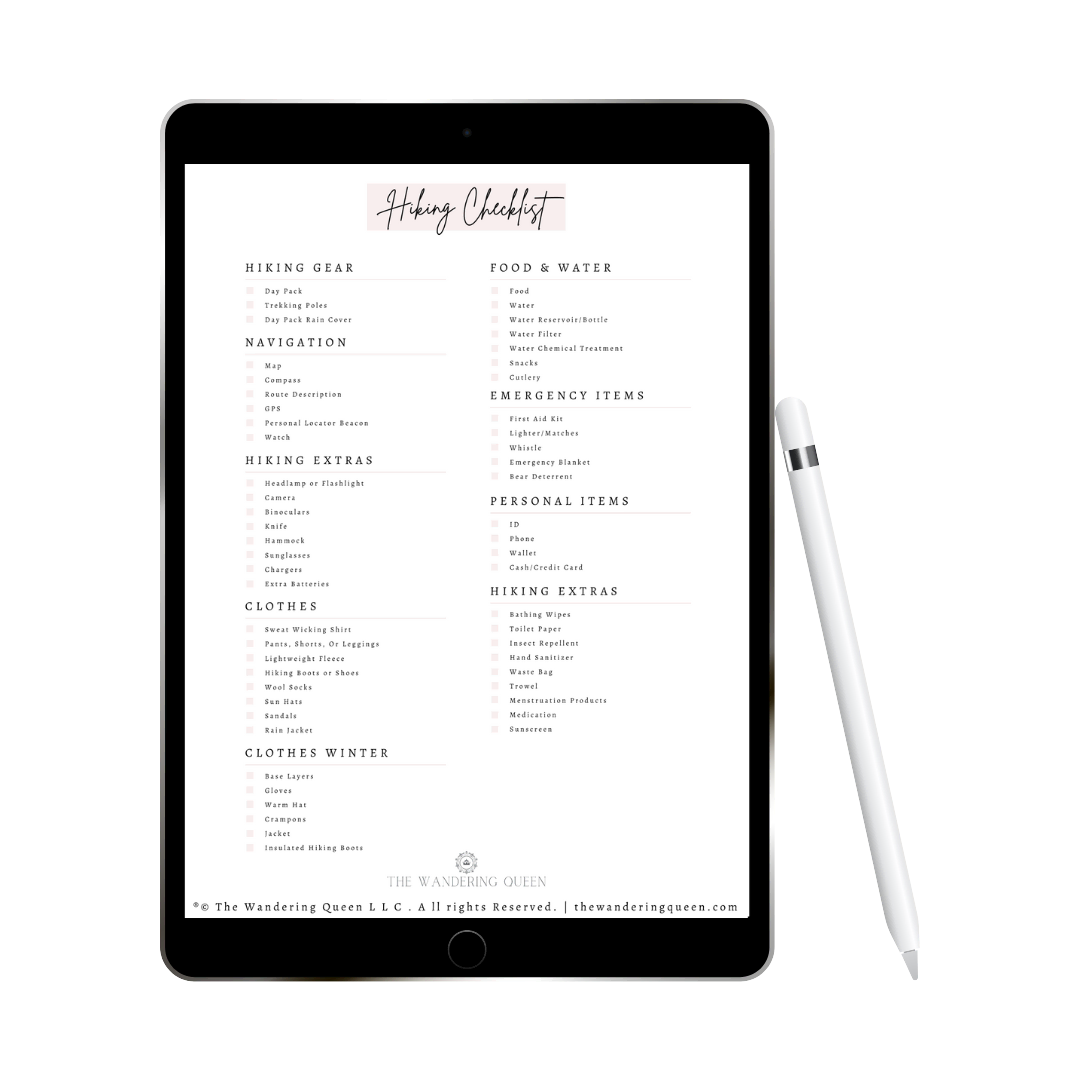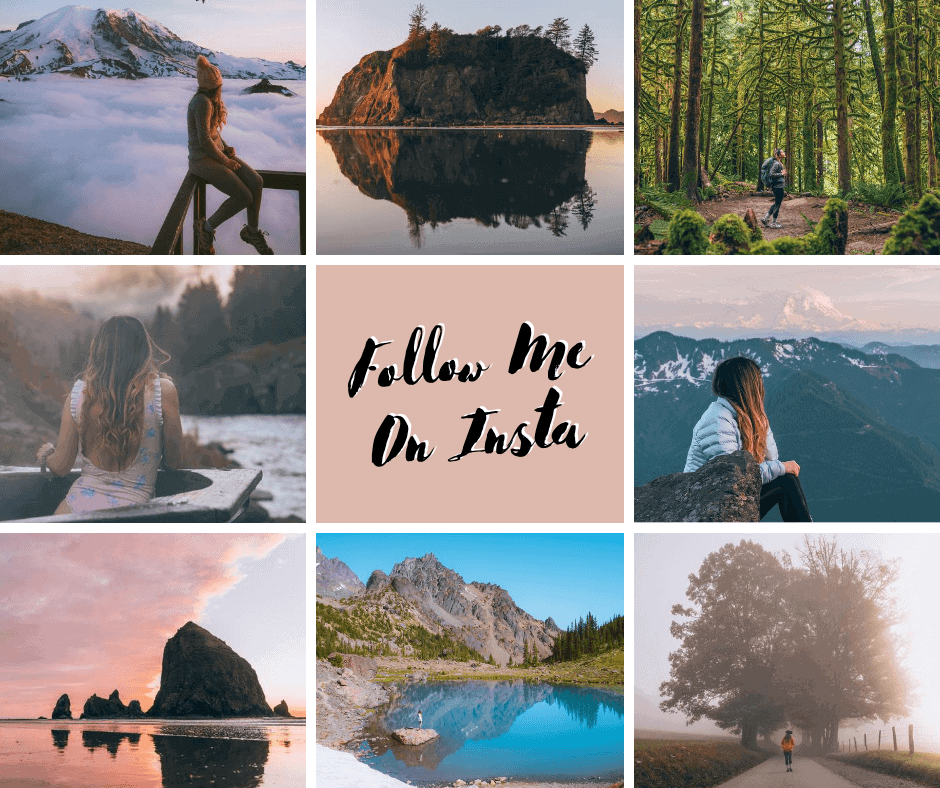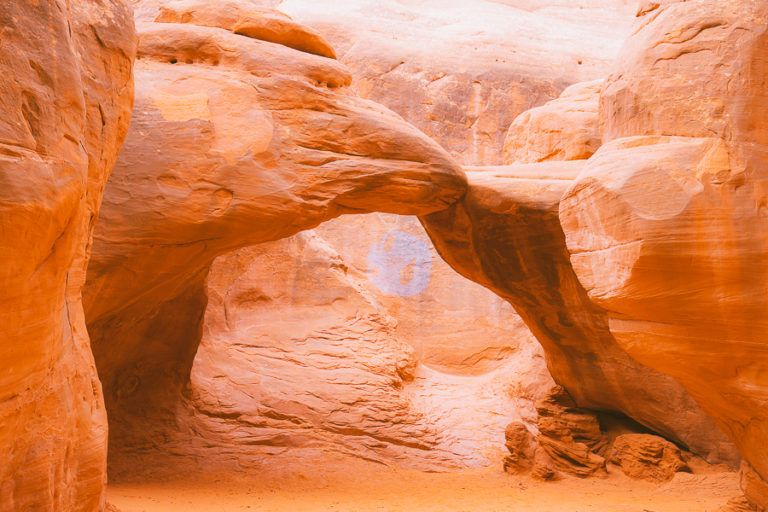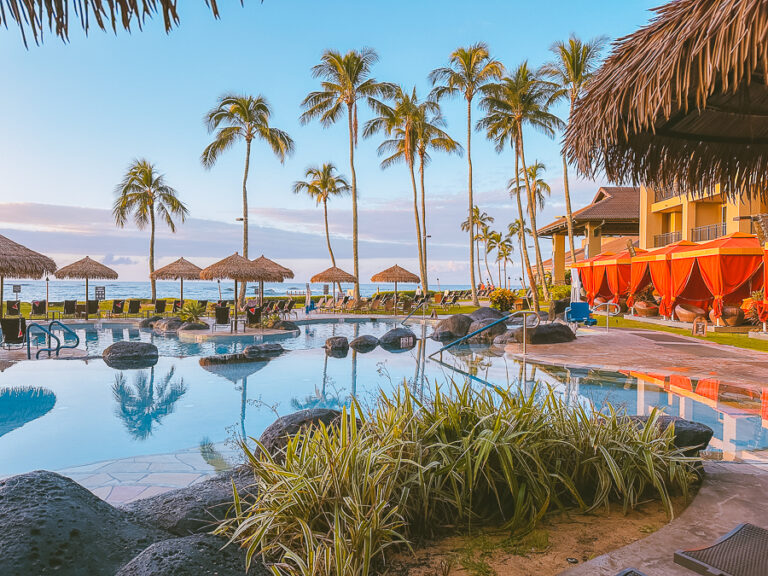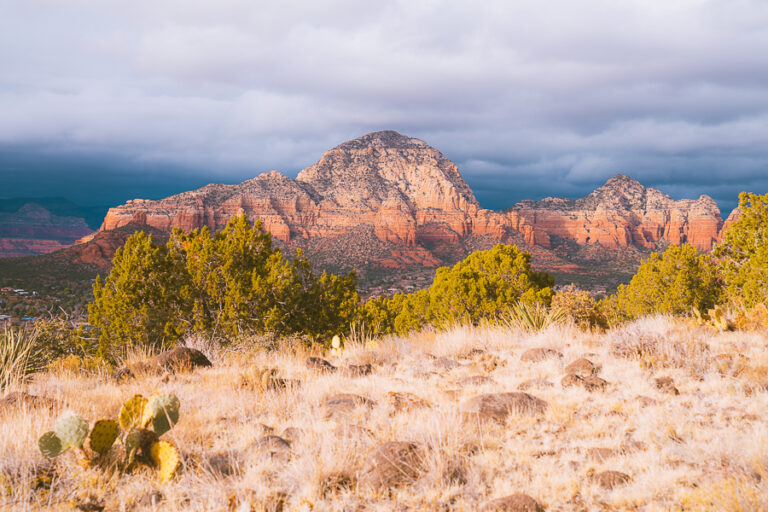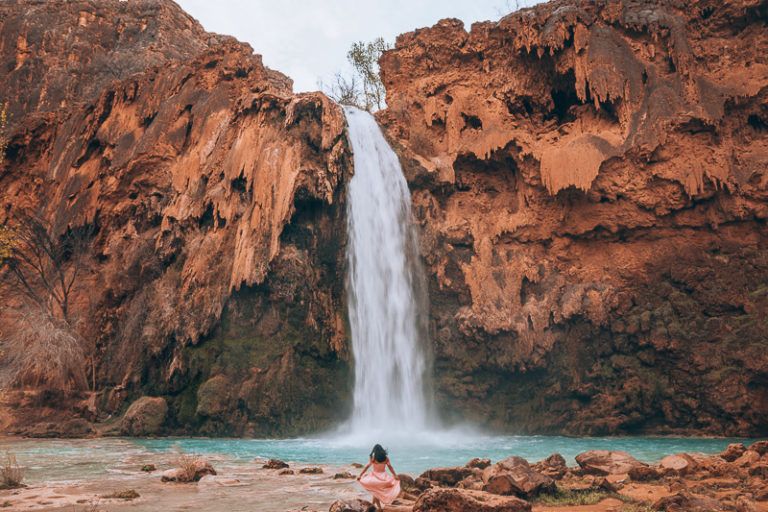Best Things to Do in Pinnacles National Park Guide + Tips
Nestled in the mountainous terrains of Central California, Pinnacles National Park is one of the state’s best-kept secrets. Formed by ancient volcanic activity, the park boasts a diverse landscape of towering rock spires, lush valleys, scenic hiking trails, and hidden talus caves.
Whether you’re a seasoned hiker, an adventure seeker, or just someone looking to escape the bustling cities, you’ll find plenty of things to do in Pinnacles National Park. This guide details how you can perfectly explore California’s smallest and youngest national park.
From trekking the best hikes in Pinnacles to wildlife spotting, rock climbing, camping, and cave exploration, there’s something to do for everyone!
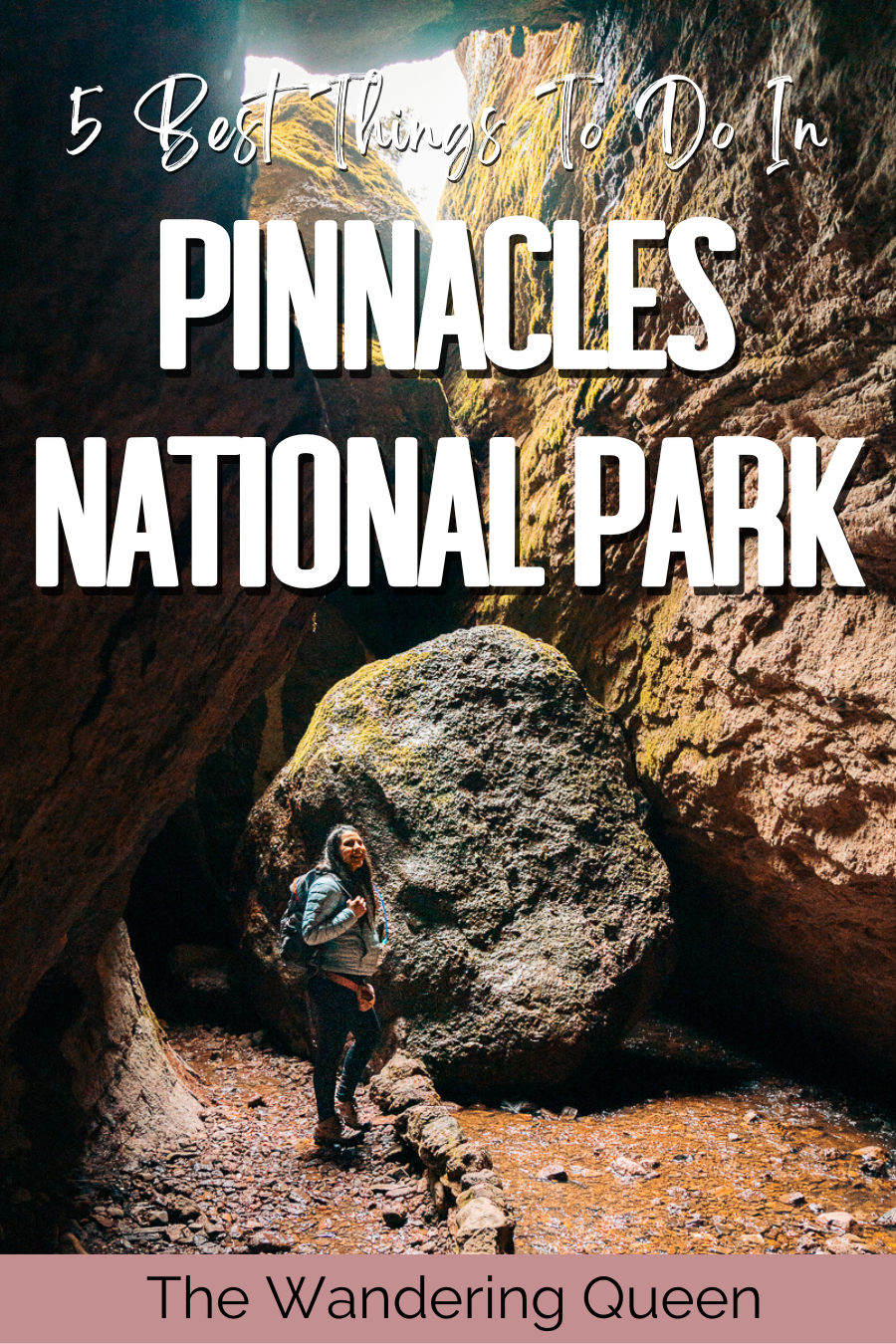
Disclosure: This post contains affiliate links. If you click one of them, I may receive a small commission (for which I am very grateful for) at no extra cost to you.
Pinnacles National Park
Related Posts
Map Of Best Things To Do In Pinnacles National Park
5 Best Things to Do in Pinnacles National Park
Now, let’s get to the nitty-gritty of how to spend your time during your visit. These are the must-do activities in the national park, from the best hikes to camping and cave exploration.
Hike the Condor Gulch Trail to Overlook
- Mileage: 2 miles (out-and-back)
- Elevation Gain: 535 feet
- Difficulty: Moderate
- Trail Guide: Link

The Condor Gulch Trail is a fantastic hike that offers sweeping views of the national park’s most popular peaks and rock formations. It also rewards you with the chance to spot the majestic California condor. This trail takes you through diverse landscapes, from chaparral to rocky outcrops, leading to the Condor Gulch Overlook, where views of the High Peaks await.
You’ll begin your trek at the Bear Gulch Nature Center Parking Lot. From there, follow the Condor Gulch Trail through the Pinnacles Wilderness. Along the way, marvel at the unique rock formations and the lush vegetation that thrives in this part of the national park.

The Condor Gulch Overlook itself is particularly rewarding. Not only is it perfect for resting and self-reflection, but it’s also a great place to spot the yellow-faced California condors. Since it’s an out-and-back trail, consider stopping for lunch at the Bear Gulch Picnic Area.
Claim your FREE Hiking Checklist
Ready to start hiking? Grab my free hiking checklist and never forget anything at home!
Trek the Moses Spring Trail to Bear Gulch Reservoir
- Mileage: 1.2 miles (out-and-back)
- Elevation Gain: 315 feet
- Difficulty: Moderate
- Trail Guide: Link

The Moses Spring Trail to Bear Gulch Reservoir is among the best hikes in the national park, merging great park features, from rocky spires and caves to stone steps and serene waters.
Start your hike at the Moses Spring Parking Area, south of Bear Gulch Nature Center. Follow the High Peaks Trail until you reach the Moses Spring Trail, which takes you all the way to Bear Gulch Reservoir. Have your camera gear ready, and you’ll want to capture this scenery.

I suggest passing through the Bear Gulch Cave along the way. The Moses Spring Trail and Bear Gulch Cave Trail cross at many points, so it’ll be easy to find your way there. It’s a unique feature of the trail, offering a cool, shaded recess during your hike.

Inside the Bear Gulch Cave, you’ll navigate through narrow passages, climb over rocks, and walk up a tight flight of stairs. This makes the Bear Gulch Cave Trail one of the most exciting adventures in Pinnacles National Park for both kids and adults.

Note: Check the cave status before heading to Bear Gulch Cave, as it’s subject to closures.
Go Camping in the Pinnacles Campground

If you’d like to fully immerse yourself in the natural beauty of Pinnacles National Park by staying overnight, you can only do that through camping. Located on the east side of the park and accessible via the East Entrance, Pinnacles Campground is your only option.
Camping in Pinnacles can be enjoyed on one of its 134 tent, group, and RV sites. The tent sites offer picnic tables and fire pits. Most RV sites have electrical hookups, shared tables, and BBQs. Many campsites are shaded thanks to the oak trees, water is available all over the campground, and there are coin-operated showers, bathrooms, and dump stations.
There is also a seasonal swimming pool, typically open from mid-April to late-September. If you don’t have a tent or an RV and are not a fan of sleeping on the ground, the campground offers canvas-sided tent cabins. These rustic cabins sleep up to four people and are open year-round.
Conquer the High Peaks Trail
- Mileage: 6.8 miles (loop)
- Elevation Gain: 1,834 feet
- Difficulty: Hard
- Trail Guide: Link
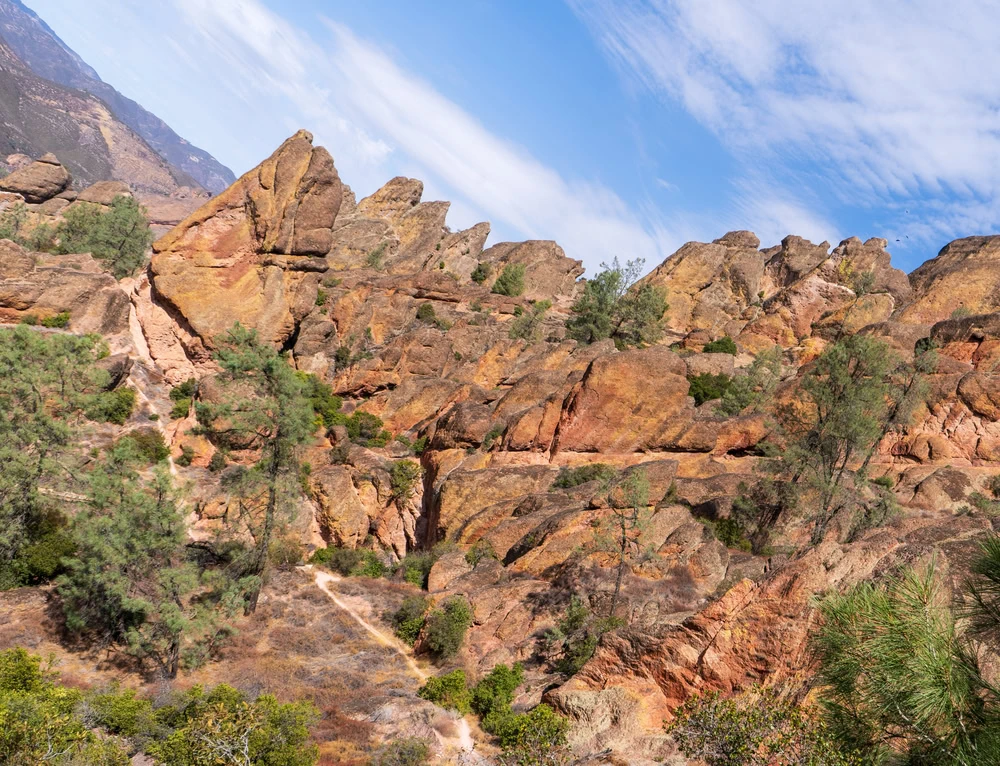
The High Peaks Trail offers one of Pinnacles National Park’s best hikes, and it’s easy to see why. Although it’s a strenuous trek, the rewarding views of volcanic landscapes make it worthwhile. This trail takes you steep climbs, narrow passages, and dramatic cliff edges.
There are many ways to access the High Peaks Trail, depending on which of the park entrances you use. From the west side of the national park, you’ll start hiking from the Chaparral Parking Area through the Juniper Canyon Trail to High Peaks.
Climb along the switchbacks, traversing through the heart of the High Peaks. At the summit, walk around the “Steep and Narrow” section before descending using the Tunnel Trail. Keep your eyes peeled for the California condors, especially in the early mornings and evenings.
If you’re on the east side of the park, use the Condor Gulch Trail to get to the High Peaks. Start your trek from the Bear Gulch Day Area, following the trail through the densest rock formations in the Pinnacles, ending the High Peaks Trail at the “Steep and Narrow” section.
Another one of the best hikes in Pinnacles National Park starts with a descent from the High Peaks to the Bear Gulch Cave Trail. Hike down the ridge through lush meadows and grass; in the spring, this area will be brimming with colorful wildflowers.
Hike to the Balconies Cave
- Mileage: 2.6 miles (out-and-back)
- Elevation Gain: 384 feet
- Difficulty: Moderate
- Trail Guide: Link
The Balconies Cave hike is an exciting trail that combines hiking with cave exploration. This trail takes you through a scenic canyon and into the Balconies Cave (one of the park’s two talus caves), where you’ll maneuver through tight passageways and climb over boulders.
You can access the Balconies Trail from the Chaparral Parking Area. Follow the trail through the towering rock formations and narrow canyons before reaching the talus cave, offering a cool, dark setting to explore, with light filtering in through cracks and openings in the rock.
The Balconies Cave is also reachable from the east side of Pinnacles National Park. You can use the Old Pinnacles Trail to Balconies Cave. This is a 5.3-mile round-trip hike with moderate difficulty.
Alternatively, you can hike from the campground along the Bench and Old Pinnacles Trails. This is a long hike, 9.4 miles round trip, and takes about four to six hours. It’s a moderately challenging hike, so carry lots of water and rest along the way.

Tip: Bring a headlight or flashlight with you so that you can easily explore Balconies Cave.
How to Get to Pinnacles National Park

The best way to get to Pinnacles National Park is by driving from one of the closest airports. You can fly into San Francisco International Airport (SFO), a 111-mile, two-and-a-half-hour drive from the national park. Alternatively, land at the San José Mineta International Airport (SJC) and reduce that driving time to one and a half hours, nearly 80 miles.
Monterey Regional Airport (MRY) is the closest option and is slightly over an hour’s (50-mile) drive. From the airport of your choice, hire a rental car and let the journey begin.
There are only two entrances available to access Pinnacles National Park: the East Entrance and the West Entrance. These are not connected, as there is no through road. This means you cannot drive from one entrance to another once you enter the national park.
You’ll have to choose to use the Pinnacles East or West Entrance beforehand. The shortest route from one entrance to another is about an hour and 15 minutes through King City.
The best way to pick the ideal park entrance is to weigh what each side offers relative to your preferences. If you’d like to go camping, you should use the East Entrance, as the only campground in Pinnacles National Park is on that side. For rock climbing opportunities, use the West Entrance. This end of the park has higher rocks and more challenging hiking trails.
Pinnacles National Park East Entrance
The Pinnacles East Entrance is accessible via the SR25 (Airline Highway), 30 miles away from the quaint town of Hollister in the north. Turn right onto SR146 (Pinnacles Highway), then take a left into the Pinnacles Campground to check in at the Visitor Center.
This side of the national park boasts many amenities, such as a bookstore that sells souvenirs and many public bathrooms. You’ll also access top attractions like Bear Gulch Cave, the High Peaks Viewpoint, and fantastic hiking trails in the Bear Gulch Day Use Area.
Visitors prefer the east side as it’s more developed and provides access to the park’s best hikes and wildlife viewing opportunities, particularly for the elusive California condor. There are also a few resting spots where you can enjoy a delightful picnic lunch.
Pinnacles National Park West Entrance
To reach the Pinnacles West Entrance, you can take the SR101 (Blue Star Memorial Highway) to Soledad, affectionately known as the “Gateway to the Pinnacles.” From there, take the SR146 (Mez Road), and after about 10 miles of driving, you’ll reach the park entrance.
There’s a range station and visitor contact center close to the West Entrance. While there might be a limited number of things to do on this side of Pinnacles National Park, you’ll have access to stunning attractions like the Balconies Cave and the Chaparral Parking Area.
Although it’s more remote, the west side presents opportunities for climbers, adventurous backpackers, and nature lovers to connect with Mother Nature in a tranquil setting. It has many of the park’s most challenging but rewarding hikes, so be ready for breathtaking views.
Best Time to Visit Pinnacles National Park

Due to its Mediterranean climate, the best time of year to visit Pinnacles is during the cooler months. Spring is considered the ideal time for hiking. From March to May, the wildflowers bloom, the grass turns green, and the national park is at its most vibrant.
Fall is one of the best times to go to Pinnacles National Park. As temperatures start cooling between September and November, the crowds start to subside. This gives you ample space to take on the toughest trails, go rock climbing, and secure a spot at the campground.
Winters in Pinnacles National Park are typically cool and wet. At higher elevations, the towering spires are lightly dusted with snow, adding a frosty charm to routes like the High Peaks Trail. In contrast, the streams at lower elevations are at their fullest and flow through the creeks. The fewer crowds from December to February mean lower lodging prices.
Summer is not the most ideal time to visit the national park. From June to August, the park experiences dry and sweltering temperatures, making hiking uncomfortable and dangerous if you’re not well-prepared. Follow the park’s list of summer visitation tips to help you stay safe.
The perfect time to visit this national park is not a one-size-fits-all. Depending on your weather preferences, budget, and Pinnacles National Park itinerary, it could be any of the four seasons. Plan ahead, check the conditions, and reserve a camp spot well in advance.
Best Places to Stay in Pinnacles National Park

There are no hotels within Pinnacles National Park, but you can still spend your nights there. Pinnacles Campground offers a variety of lodgings, from tent and RV sites to canvas-sided tent cabins. These rustic accommodations are perfect for connecting with nature, but if you want a convenient stay, there are hotels in cities like Soledad, San Benito, and King City.
Here are some nearby options for where to stay when visiting Pinnacles National Park:
Budget | Soledad Motel 8
Soledad Motel 8 offers a comfortable and affordable stay, perfect for the budget-conscious traveler. It’s located a short 20-minute drive from the park’s West Entrance, so you’ll have easy access to Pinnacles National Park without breaking the bank.
This no-frills motel offers essentials, like a minibar and micro-oven, free Wi-Fi, bilingual staff, and clean, spacious rooms, perfect for a restful night. Motel 8 is an excellent choice if you’ll spend most of the time exploring the national park and need a simple, convenient place to stay overnight. There are many gas stations, restaurants, and wineries to explore nearby. >>>Check Availability
Mid-Range | The Tumbleweed Hotel
Nestled on a 1,000-acre ranch with views of rolling hills and olive orchards, The Tumbleweed Hotels offers mid-range comforts that ensure a cozy and convenient stay. The hotel is a reasonable distance from the park, only taking a 21-minute drive to reach the East Entrance.
The hotel features well-appointed rooms with modern amenities, ranging from an equipped kitchen to a quaint dining area and sizable rooms to lay your head at night. The backyard and fragrant, lavender-filled garden are wonderful spaces to relax after a long day of hiking. >>>Check Availability
Luxury | Chalone Pinnacles House
Boasting incredible vineyard views and top-notch amenities, this luxurious farmhouse offers an elegant stay near Pinnacles National Park. It’s just a stone’s throw away from Chalone Vineyard Airport, so it will only take you a mere five-minute drive to the West Entrance.
The house has multiple bedrooms with deck or patio views, various sitting and dining areas, a gourmet kitchen, and an Olympic-size pool that’s heated all year round. You’ll have plenty of entertainment to keep you busy after exploring the national park, like a game room with a pool table, a gorgeous garden, and a jacuzzi. It’s very ideal for families and large groups. >>>Check Availability
Download my free Outdoor Photography Guide
Tips for Visiting Pinnacles National Park

By now, you’re ready to take on these awesome things to do in Pinnacles National Park, but before you pack your bags, have a look at these tips and things to know before you visit:
- Plan Ahead of Time: Decide on your top things to do in Pinnacles National Park so you can use the most suitable of the two entrances.
- Pick the Right Season: Depending on what you want to see and do, choosing the season to visit can make or break your trip. Cooler seasons like fall and spring are ideal for hiking, birding, and spotting wildflowers. Winter has fewer crowds, and summer days can get extremely hot.
- Stay Hydrated: Carry plenty of water, especially during hot weather. The park can get very warm, even in the cooler months. So, staying hydrated when tackling the best things to do in Pinnacles National Park is crucial for your safety and enjoyment.
- Wear Durable Shoes: Sturdy hiking boots are recommended for navigating the Pinnacles’ rocky terrain. Proper footwear can prevent injuries and make your hikes more comfortable. It also protects your feet from prickly objects along the trails.
- Carry a Daypack: Bring a small hiking bag to carry your refillable water bottle, SFP 50 sunscreen, maps, and other hiking essentials. You should also bring energy-boosting snacks to keep you fueled during hikes.
- Check the Cave Status: Before heading to Bear Gulch Cave or Balconies Cave, make sure you check the cave status, as they are both subject to closures.
- Respect the Wildlife: Observe animals from a distance and do not feed them. Keeping wildlife wild ensures their safety and preserves the natural ecosystem, especially for critically endangered species like the California condor.
FAQs About Pinnacles National Park’s Things to Do

Still have some questions? Here are the answers to the frequently asked questions about the best things to do in Pinnacles National Park.
Is Pinnacles National Park Worth Visiting?
Absolutely! Pinnacles National Park offers a unique blend of geological wonders, diverse hiking trails, and opportunities to see rare wildlife like the California condor. The park’s distinctive rock formations make it a visually stunning destination.
How Long Should You Spend at Pinnacles National Park?
Two days is enough time to explore the national park. It gives you ample opportunity to hike the best trails, spot wildlife, rock climb/scramble, and explore the talus caves.
If you’re short on time, you can still see and do a lot in just one day in Pinnacles National Park. But keep in mind you’ll have to drive at least an hour from one entrance to another.
Which Side of Pinnacles Is Better?
Both sides of Pinnacles National Park have their unique charm. The east side is more accessible and provides many amenities, while the west is slightly more secluded. You’ll find hiking, rock climbing, and cave exploration opportunities on both sides.
If you prioritize camping, the east side is your only bet, and if you’d like to spot California condors soaring in the skies, then opt for the west side of the national park.
What Do You Wear to the Pinnacles?

Wear layers, as Central California temperatures can vary throughout the day. Comfortable hiking boots, a hat, and SPF-rich sunscreen are essential. In summer and early fall, breathable and light-colored clothing are recommended to protect yourself from soaring temperatures.
In cooler months (late fall, early spring, and winter), bring a jacket and warm layers. Always check the weather forecast before your visit to Pinnacles National Park to dress accordingly. Below is a more comprehensive list:
- Bug Spray: Bring some good bug spray, just in case. >Buy Some Here
- Sunscreen: One of the ten essentials! I always bring this with me. >Buy Sunscreen
- Hiking Boots/Shoes: If you use tennis shoes, you can easily hurt your toes by hitting a rock by accident (Trust me I have done it so many times). >Check Out My Hiking Shoes
- Hiking socks: Having the correct socks helps prevent blisters while hiking. Smart Wool is probably my favorite brand out there. >Buy Hiking Socks
- Refillable water bottle: I always bring a Hydroflask on all my adventures. They are on the heavier side, but I know for a fact they will not break. I have had a few cheap water bottles break on me before. >Check Prices Now
- Water Reservoir: You might need more water than a water bottles worth. The great thing about this reservoir is that it doesn’t have the plastic taste. >Here Is My Water Reservoir
- Water: Stay nice and hydrated.
- Sunglasses: It can get sunny, so make sure to pack some sunglasses. >Check Out These Sunglasses
- Snacks: The best snacks are jerky, nuts, energy bars, and extra food. >>>Check Out These Snacks!
- Camera: The camera I have linked was one of the first cameras I started using on my travels. The Sony A6000 is an excellent camera for people that want to start improving at travel photography. >Buy Sony Camera Here
- First Aid Kit: This is one of the first things I bought when I first started going on adventures. It is super portable. >Buy This Awesome First Aid Kit Here
- Day Pack to carry all your things: The REI bag I have linked, we have had for seven years now, and it is still going strong! >Buy This Great Quality Backpack
- Leggings or Hiking Pants: I love wearing leggings while hiking because I love how comfy they are. Here are my leggings. >Click For My Leggings
- Breathable sweat-wicking shirts: Try not to wear cotton because it soaks up your sweat and can cause hypothermia in the mountains. >Buy Shirt Here
- Sports Bra: For women >>>Click Here
- Jacket: If you go in the winter a jacket! >Buy My Favorite Jacket
- Tripod: This is an optional item, but it is excellent for getting the ideal sunset pictures. >Check out this tripod
- Fire Starter and Matches: This is just in case of an emergency. >Buy These Stormproof Matches Just In Case
- Compass: I always carry this with me, just in case. >Click Here To Buy
- Knife: You never know if you will need it. >Buy My Knife Here
- Headlamp: A headlamp is an absolute must to explore the caves. >Buy A Headlamp Now
- Trekking Poles: I recommend these for people with bad knees like me. >Buy My Poles
- National Park Book: >>>Check it out Here
- National Park Pass: If you are an avid hiker like me, it’s worth getting the year-long America The Beautiful Pass. >Get It HERE
Claim your FREE Hiking Checklist
Ready to start hiking? Grab my free hiking checklist and never forget anything at home!
Wrapping Up What to Do in Pinnacles National Park

Pinnacles National Park is a fairly unknown gem of central California, offering a diverse range of outdoor activities and out-of-this-world natural beauty. Whether you’re looking to hike through the volcanic terrains and lush meadows, explore its caves, or simply catch a glimpse of the California condor, Pinnacles National Park has something special for you.
From challenging hikes to serene picnic spots, Pinnacles provides a perfect escape into nature, promising adventure and relaxation to everyone. So, pack your bags, book your lodging, and get ready to experience an unforgettable time in this remarkable park.
Next Read: Explore more of California’s national parks with these amazing things to do in Sequoia National Park.

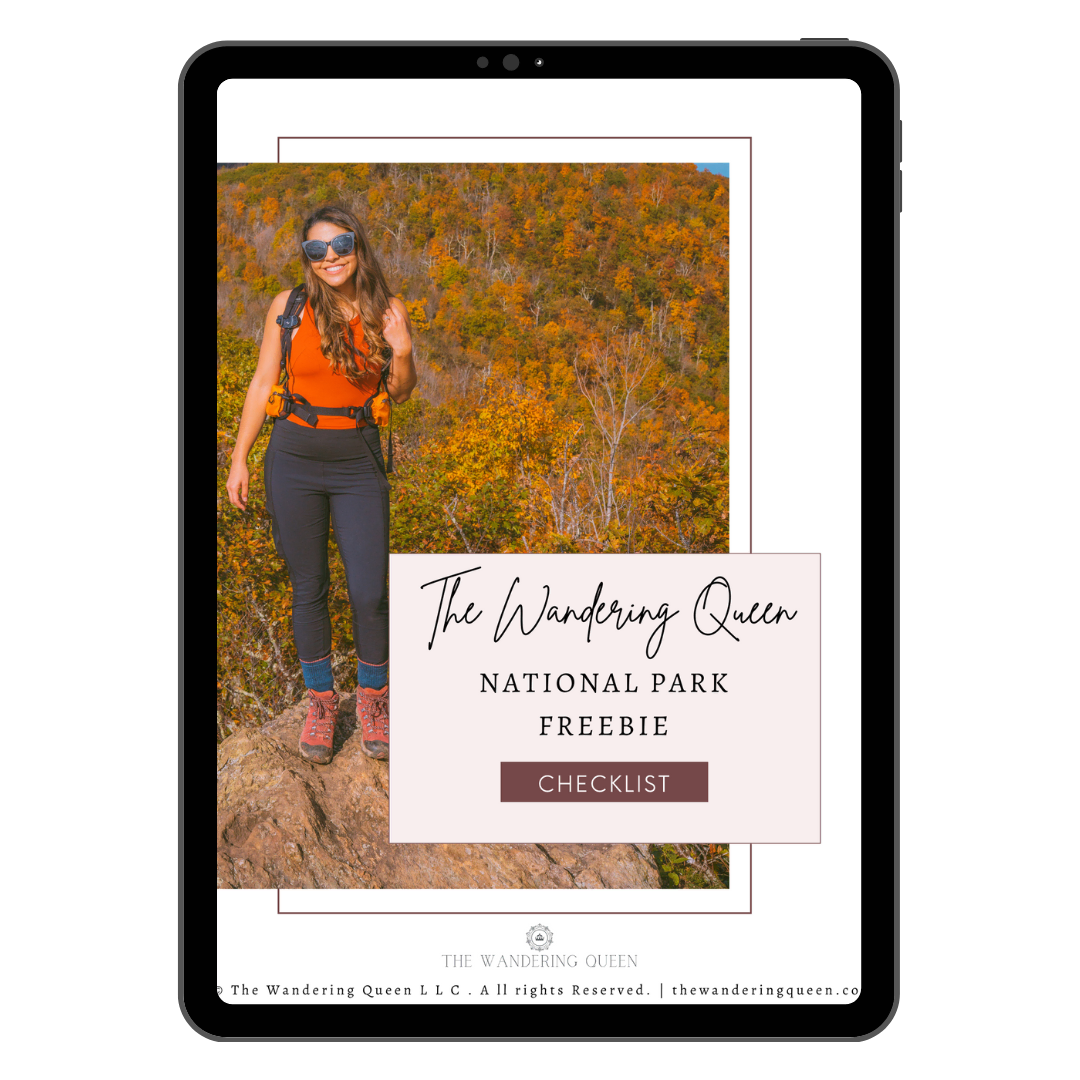
Get my free National Park Checklist
When you join the newsletter!
Pin For Later: Things to Do in Pinnacles National Park


